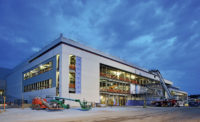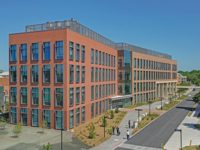Designed to embody the innovative spirit of Oregon State University’s prominent alumnus, the $62-million Linus Pauling Science Center will house the research institute devoted to advancing knowledge in the chemist’s interest areas.
“This is the first large building to go into OSU’s historic district,” says John Gremmels, project manager for the university in Corvallis.
The challenge was to develop a state-of-the-art research building for students and faculty in the university’s College of Science and keep it within the historic context, says Mark Foster, a design partner with Zimmer Gunsul Frasca Architects of Portland, which designed the four-story, 105,000-sq-ft structure that is destined to become the university’s largest academic building. Brick and precast will clad the exterior and complement the historic district’s brick and stone.
The university was interested “in creating a living, working memorial to Linus Pauling, and that was about quality of the lab space and space in the building,” Foster says.
Pauling, a native of Portland, pioneered chemical bonds and worked with vitamins. He received the Nobel Prize in chemistry in 1954 and the Nobel Peace Prize in 1962. He remains the only person to win two Nobel Prizes in different categories.
“Pauling was one of OSC’s most distinguished alumni,” Gremmels says.
Pauling founded the Linus Pauling Institute of Science and Medicine after retiring from Stanford University in 1973. The institute moved to Oregon State in 1996 and has outgrown its current space in multiple buildings. The new structure will bring all of its investigators under one roof, which the school says should foster collaboration.
“For a good interdisciplinary, cohesive approach to pursing our research mission, it’s good to have people physically situated together so they can interact as often as possible,” says Stephen Lawson, administrative officer of the Linus Pauling Institute. “We have an open laboratory design, which will allow for cross-talk among researchers working next to each other and in adjacent laboratories.”
The building also will provide modern research and classroom space for the chemistry department. About half of Oregon State’s 10,000 students take chemistry classes annually.
Andersen Construction of Corvallis broke ground on the science center in September 2009, topped out in May and is about half finished with the project. The building is scheduled for completion in June.
The structural-steel frame building sits on a spread-footer foundation.







Post a comment to this article
Report Abusive Comment